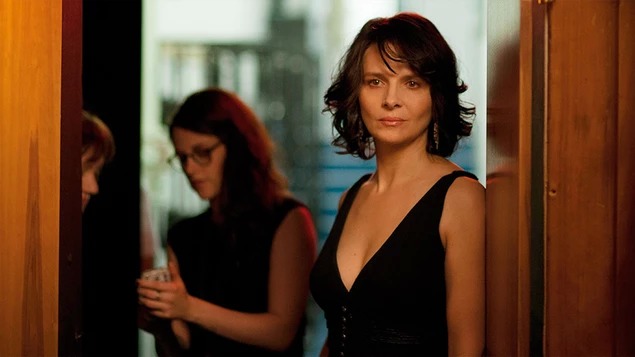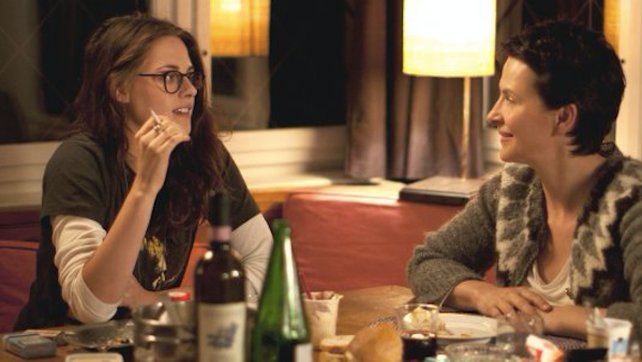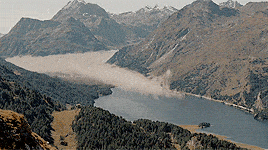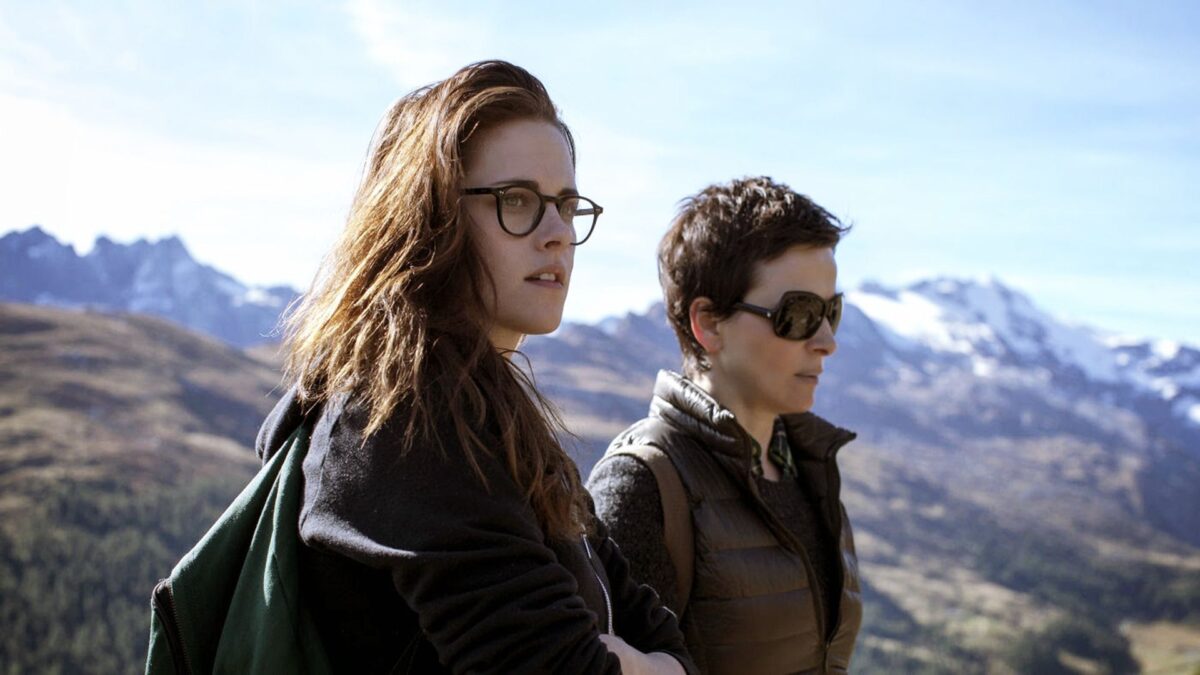To convey the nuance of its thematics, Clouds of Sils Maria primarily relies on dialogue between characters. So this ending explanation involves a lot of dialogue. But once you have the context of the dialogue, the whole movie becomes clear. It kind of reminds me of one of those illusion pictures. Show it to someone without context, and they’ll see Perspective 1 or Perspective 2—almost never both. But once you reveal the alternative perspective…all the confusion goes away.
Time, Time, Time
One of the key in-roads for Clouds of Sils Maria happens at the the end of the movie. Maria (Juliette Binoche), a few moments before the opening of the play Maloja Snake, takes a meeting with a young filmmaker who wants to pitch her on a role.
This is the conversation.
Maria: I read your script Director: I know we’ve never met, but I actually wrote it with you in mind. M: As a mutant? D: I’m trying to consider genetics from a more human point of view. M: When I was reading it, I imagine someone much younger. Maybe me younger, actually. But you were seeing me in movies that were made years ago. I’ve changed. D: She has no age. Or else she’s every age at once, like all of us. M: Can I be frank? Maybe it’s because I’m working with her, as I was reading it, I kept thinking about Jo-Ann. D: Personally, I never think about Jo-Ann Ellis. M: You’re wrong, she’s smart. And talented. She’s modern, just like your character. D: My character isn’t modern. Not in that way anyway. She’s outside of time. M: Outside of time? I don’t understand. It’s too abstract to me. Sorry. D: I don’t like this era. M: You’re wrong. It’s yours. D: Hey man, I didn’t choose it. And if my era is Jo-Ann Ellis and viral internet scandals, I think I’m entitled to feel unrelated. It’s nothing against her, I just thought you’d understand.
This conversation might strike viewers as odd, as it doesn’t contribute to the plot in anyway. Two minutes later the movie is over. The filmmaker didn’t appear at any point prior to this, so this isn’t the conclusion to his character arc. So why include it?
I talk about this a lot so I’m sorry if this isn’t your first time reading what I’m about to write. But the rule of thumb is that if a scene seemingly has no purpose regarding the plot…then it has thematic relevance. One way to understand the thematic relevance is to pay attention to any repeating elements. You may have noticed the bolded and underlined words.
Time is clearly a focus. But it’s not just time. It’s time in relation to age. In other words: mortality. Maria’s views on her age are pretty clear: she’s beyond her youth, this is no longer her era, Jo-Ann is a more appropriate choice for a futuristic role.
This seemingly throwaway scene, having nothing to do with the main plot, is arguably the most important in the movie. That’s because the the purpose of Clouds of Sils Maria is to be a meditation on aging. All the plot stuff about the play Majola Snake and Maria’s conflict over being part of it, the drama of her preparations for it, the drama with Val, the drama with Jo-Ann Ellis…it’s all done in order to explore Maria’s existential relationship with aging.
Youth and Fate
Clouds of Sils Maria confronts Maria with a crisis: she’s getting older. The concept of “aging” has many philosophical connotations to it, but the movie zeroes in on two.
- Loss of youth and all that implies—physically, mentally, emotionally, culturally, etc.
- Aging means you’re approaching death.
Before Maria accepts the role of “Helena” she appears youthful and vigorous. Her appearance changes as she prepares for the role.


The physical change isn’t surprising. Actors morph their body to fit the part they’re playing. It’s part of the job. What’s more relevant to Clouds of Sils Maria is the psychology behind such a change. The sense that once you cross a certain line that there’s no going back.
In order to play Helena, Maria must accept she is that woman. Not just the character, but an actress appropriate for the role. Maria had gained her initial fame by embodying the play’s young enchantress, Sigrid. All these years later what’s it mean for her to be Helena? The implication of that contrast is the core philosophical conceit of the film.
Some everyday examples of that would be things like: becoming principal of the high school you attended; when you’re a parent and your child has milestone after milestone and it makes you think about your own childhood and milestones and where the time has gone; or that moment when you’re the old person who dislikes all new music and doesn’t know how to use technology. Juxtapositions like this that are dependent on changes over time tend to force us to consider how much time has passed. Which forces us to consider how much older we’re getting. Which forces us to consider that death approaches.
Beyond Maria having to accept she’s aged to the point where she’s suitable for Helena…she’s confronted by the fact that Helena’s fate is doom. In the play, Helena’s character arc is three phases: she has a romantic relationship with Sigrid and things are good for her; she discovers Sigrid has betrayed her and things are bad for her; she commits suicide (or so the play implies).
Over the course of the movie, we watch Maria struggle to accept the reality of her age. Because if she accepts the reality of her age, she has to admit she’s no longer the one who bends the world to her will (aka Sigrid), but is the one who is allured by the next generation, the Sigrids of the world, the youth she’s lost. The superficial question of the movie is, “Can Maria accept this role?” But that’s really a way of asking, “Can Maria accept she’s aged?”
To Fight or Not To Fight
Through the middle section of Clouds of Sils Maria, we witness the back and forth dynamic between Maria and her assistant, Val (Kristen Stewart). While the two women get along, Val has moments of inexperience around Maria that make Val self-conscious and Maria frustrated. But Val also has moments of being more in touch with the world and pop culture in a way that Maria isn’t. Which once again makes Val self-conscious and Maria frustrated.
There’s a sense in this period that Clouds has gone for some meta-narrative. That Val and Maria are actually living the play they’re rehearsing, Maloja Snake. For a few seconds or minutes or a solid hour, you might be waiting for Val and Maria to have a fling, for Val to, like Sigrid, break Maria’s heart. That’s kind of what happens but kind of not.

The assistant/actor dynamic is a slanted recreation of the powerful business woman Helena and her employee/lover, rather than a full re-enactment, which is why we never see the pair jump off that romantic diving board. Instead, their relationship is more spiritual, more about kinship. Maria relies on Val and the two are clearly friends. It appears Val does her job as much out of professionalism as out of genuine compassion and respect and concern for Maria.
But the same way that Sigrid leaves Helena, Val leaves Maria.
It’s one of the scenes in the film that confuses people the most. Why did Val leave? Why didn’t she come back? What happened to her? Remember, the two women are hiking to the top of the mountain to try and see the phenomenon of the moving clouds (known as the Majola Snake).
Maria: I spent all night thinking about Helena’s death? Val: Her death? She doesn’t necessarily die. She disappears.
M: That’s your interpretation.
V: It’s pretty ambiguous.
M: She goes out for a hike and never comes back. Seems clear enough to me.
V: You don’t know that. She could reinvent herself somewhere else. There’s no real way of knowing.
M: You can imagine anything you want. Are we going the right way? I don’t mind waking up at the crack of dawn, but not to get lost in the mountains and miss the snake.
V: Well we’re basically here. You happy?
M: What makes you think we’re here?
V: I’ve got a map! Want me to show you? This is the bend we went around 10 minutes ago. And just around there is the view of the valley.
M: How do you know?
V: H— You’re a pain in the ass, Jesus Christ.
M: I don’t know why you’re so dead set on making this play say the opposite of what it was meant to say.
V: At twenty, you saw Sigrid’s ambition and you saw her violence because you felt it in yourself.
M: So?
V: So that’s what I’m saying. The text is an object. It’s going to change perspective based on where you’re standing.
M: I don’t know.
V: We should go, we’re going to miss the snake.
M: There won’t be any snake.
V: Psh. F*ck it. [It’s here the two women disappear from the frame, as the land dips. When Maria appears, marching up the hill, Val is nowhere to be found.]
M: Look there, is that the snake?! No. No it’s just mist. A little fog. It breaks up. Still very beautiful, huh? It’s like it’s gathering and pouring out into the valley. Maybe it is the snake. We’ll have to be patient. No it’s not the snake. Oh yes! I think it’s turning into the snake. How bout you—Val?! What the hell are you doing?! VAL! VAL!!!! VALLLL! VAAAAL! VAAAAAAAL! ANSWER ME!!!! VALLLLLLL! VAAAAAL!

At this point the snake comes through. An object that changes perspective based on the viewer. We witness Maria think it’s the snake. That it’s not the snake. It is. It isn’t. Before she goes off in search of Val. The camera remains, leaving the viewer to confirm that, yes, it was the “snake”. Though someone else might think it’s more flowing water, or a caterpillar, or what have you. Their perspective (based on their life experiences) defines how they view the clouds of Sils Maria.
Which is the exact lesson Val wanted to teach Maria: just because you think Helena disappearing means suicide…it can mean many other things. Val’s disappearing is her saying, “I’m sacrificing my job and our relationship to prove this point. You know I’m not dead, that I’m working some other job, living my life just fine. Helena could be doing the same.”
This ends the “main story” of the movie. Everything else is the epilogue.
Epilogue
It’s impressive to me how much the movie ramps up in the epilogue. As I detailed, everything leading up to this point is focused on Maria and her crisis with aging. But now we’re in the aftermath. She had a choice to make and she made it (sometime during Val leaving and the start of the epilogue). Our task as viewers is to realize what that decision was and observe how it now defines Maria.
Remember Val’s words, “The text is an object. It’s going to change perspective based on where you’re standing.” That’s spoken as much to Maria as it is to us, the viewer. Our interpretation of what comes next will be based on “where we’re standing.” Watching the movie as a 20 year old will be different than as a 50 year old.
Once we’re in the epilogue, we get a few scenes.
- Maria talking to her agent/manager
- Dinner with Klaus and Jo-Ann
- Maria with her new assistant
- Rehearsal
- Klaus talking to the reporter
- Jo-Ann (Chloe Grace Moretz) defeats Maria
- The conversation with the young director
- The minute before the curtain opens
Here’s a smattering of quotes from these scenes. Pay attention to the repetition of topics we’ve already discussed.
Maria to her manager: “You know how reluctant I was. I’m over that now.”
Maria to Klaus: “How old was Wilhelm when he wrote Majola Snake? 35? 38? Well, he was still a young man. All action…25 years later obviously he’s more analytical, trying to put things into perspective. Isn’t it better to stay faithful to his youthful energy?”
Klaus to Maria: “Wilhelm never had any distance on maturity. On the contrary, his last texts got bolder and bolder, and more and more enigmatic. Here’s another way of looking at it. We think like him. We project ourselves into the future instead of freezing [?] ourselves in the past.”
Maria to her assistant [regarding the new scenes Klaus was referring to 2 weeks earlier]: “I’d rather discover them at the last minute and not overthink it. It’s the only way I can keep it spontaneous. It’s how I prepared Sigrid twenty years ago. I’ll do the same with Helena.”
Klaus to the reporter: “Each theater goer brings his own subjectivity.”
Maria to Jo-Ann: “You leave without looking at me. As if I didn’t exist. If you could pause for a second. Helena’s distress would last longer when she’s left alone in her office. The way you’re playing it the audience follows you out but instantly forgets about her….Well when I played Sigrid I held it longer. I thought it was more powerful, dramatically. I mean it really played well.”
Jo-Ann to Maria: “I mean no one really gives a f*ck about Helena at that point do they? I’m sorry, I mean it’s pretty clear to me this poor woman’s all washed up. I mean your character, right, not you [said condescendingly enough that it’s hard to believe her]. And when Sigrid leaves Helena’s office, Helena’s a wreck and we get it. It’s time to move on. I think they want what comes next.”
Maria to Jo-Ann: “You’re right. Huh. I think I’m uh lost in my memories. You think you’ve forgotten your old habits. But they all just come back. I’ll have to break them.”
Look at that. Almost every line has something to do with age or perspective! Or directly demonstrates the subjectivity of a situation. Klaus views Wilhelm’s work one way, Maria views it another. Maria thinks the scene is more powerful if the audience feels Helena’s distress, whereas Jo-Ann thinks the audience doesn’t give a f*ck about Helena by that point.
I think this pretty conclusively answers the question: “What is going on in Clouds of Sils Maria?” It’s about aging and perspective.
I’d say writer/director Olivier Assayas purposefully left the movie a bit open-ended and amorphous, rather than give it a definitive ending. In that way, the form and function of the narrative is similar to that of a cloud, allowing those who view it an opportunity to bring their own perspective on it.
Bonus 1: A wrinkle in time
A bit of nuance that jumps out to me. As much as the movie talks about the fluidity of perspective, and how age changes us, it also seems to subtly hint at fixtures of character.
For example. Maria offers that Wilhelm went from “youthful energy” to “more analytical” 25 years later. But Klaus counters that “Wilhelm never had any distance on maturity.” Maria is similar in that she seems beyond abstraction. Remember her conversations with Val and the young director.
“Outside of time? I don’t understand. It’s too abstract to me. Sorry.”
“She goes out for a hike and never comes back. Seems clear enough to me.”
The reaction to the Majola Snake is the ultimate expression of this character flaw (for lack of a better term). This abstract thing, clouds that look like a snake, is something Maria struggles to come to a conclusion on.
This fixture of character feels reinforced by Maria’s response to Jo-Ann. “You think you’ve forgotten your old habits. But they all just come back. I’ll have to break them.” Which habits can we break? And which are just…who we are, uneditable by willpower or time?
Bonus 2: Go gentle into that good night, or don’t.
The last conversation between Maria and Jo-Ann has Maria explain to Jo-Ann the (perceived) importance of Jo-Ann pausing in a scene to allow Helena’s distress to last longer when Helena’s alone in her office.
The last shot of the movie is the camera moving across the stage and pausing on Maria before cutting to black.
We should recall Jo-Ann’s words about the last time we see Helena. “No one really gives a f*ck about Helena at that point do they? I’m sorry, I mean it’s pretty clear to me this poor woman’s all washed up.”
I think viewers are left to decide if they think Jo-Ann’s right or wrong—not about Helena but about Maria. Maria did just turn down the role in that young filmmaker’s movie. Feeling she wasn’t right for it and Jo-Ann was. Which means that last shot is, for those who want to see the “glass half empty” ending, one last look at Maria before her distress overcomes her.
With that said, narrative’s will often have an antagonizing character give a strong-and-wrong worldview that a hero can overcome. Imagine if Empire Strikes Back ended with Emperor Palpatine yelling out, “Vader will never betray me! He’s given his life to the Dark Side!” That would set up Vader returning to the light by betraying Palpatine, saving Luke, and redeeming himself. Clouds of Sils Maria being a more artistic movie would use the first part of that technique (the declaration) without showing the final part (the character action). Instead, it would leave us—the intelligent, thoughtful audience—to put the pieces together.
Some viewers will come to a positive conclusion about that final shot. As contrary to Jo-Ann’s statement that “no one gives a f*ck about her” at that point…we still care about Maria. This could just be the start of a new chapter rather than her swan song. Which lines up with Val’s “sacrifice”. Just because we can’t see what happens to Maria doesn’t mean she’s doomed.


Maria and Val were the same person the entire time, kind of like Brad Pitt and Edward Norton in Fight Club. Most people just miss this part of CoSM.
How do you explain that Val is there and acknowledged by other characters when Maria is present, and Maria introduces Val to other characters. If she still doesn’t really exist, what are we to think of what the other characters are experiencing? Sorry, your theory does not fit the movie.
Val and jo-Ann represent youth. They are one and the same. When Jo-Ann tells Maria why she won’t pause for a second in the play she is describing why Val left or why her youth is leaving her. Then Maria accepts that her youth has left. Val is Maria’s youth.